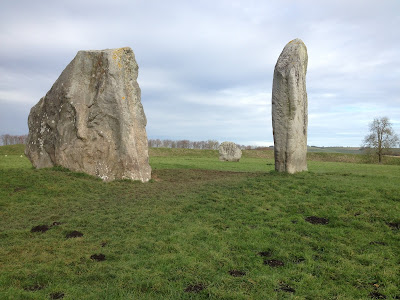Avebury henge
in Wiltshire is Britain’s largest stone circle and formed part of a vast
complex of monuments built and used over 2000 years. The story of its
construction will perhaps never be fully understood.
It seems the
earliest structure was a large wooden building, perhaps a house or hall which
often featured at the earliest Neolithic settlements. After its demise it
became the focus of a square arrangement of stones, now long removed. The
building was perhaps built by the first settlers in the area, now revered ancestors,
and was immortalised in memory as an example of ‘history-making’. This was
eventually followed by the henge ditch and bank, then the huge outer stone
circle with two smaller circles inside were raised, then finally two stone avenues
were added.
The linear 'z-feature', with the south ring and the southern entrance stones beyond.
Avebury is in
a natural ‘bowl’ surrounded by higher chalk ridges, one being the course of the
ancient trackway called the Ridgeway. Although the henge is visible from the
high ground all around, it’s surprisingly inconspicuous. Many stone circles are
prominent in their landscape, designed to be seen, which suggests a different
reason for Avebury’s location or purpose. Although, perhaps its size and
therefore importance and fame meant it didn’t need to advertise itself. Inside the
monument, little is visible of the outside world and it gives the impression of
being an enclosed ‘microcosm’. It has often been suggested that circular
monuments surrounded by a water-filled ditch are a microcosm of the earth with
its surrounding ring of water.
Avebury comprises
a circular ditch with an outer bank, 330m in diameter. The ditch was originally
nine metres deep; a phenomenal undertaking using only antler picks. It was dug around
2900BC, replacing an earlier, more modest ditch. The stone circle inside
comprised 98 huge sarsen stones, weighing up to 100 tonnes, many of which were
destroyed or buried during Medieval times. Two smaller circles, around 100m
diameter, were built inside the monument, and a variety of other stone features
whose original layout and purpose remains unclear. Four causewayed entrances,
slightly offset from the cardinal points, are the locations for the modern
roads.
The two very different Cove stones in the northern circle.
Avebury’s
earliest phase of construction was during the early Neolithic period, but intriguing
evidence suggests its importance began long before this point. Many sacred
sites in Britain, immortalised in stone during the Neolithic and Bronze Ages,
were respected by the earlier hunter-gatherers who had populated Britain after
the Ice Age. Neolithic settlers, or hunter-gatherers who adopted the farming
lifestyle, built these monuments around natural features whose importance was
perhaps known to a few and now forgotten or ignored by most. Groves, springs or
rock features became an immortalised memory.
Avebury’s
biggest sarsen stones, such as the now-destroyed Obelisk in the southern circle,
the Cove Stone in the northern circle, and some of the entrance stones, are believed
to have been naturally present, in contrast to the majority of the stones which
were dragged into place from the nearby downs. Were they subject to
millennia-old veneration and the reason for the henge’s location? Intriguingly,
some stones at Stonehenge and Stanton Drew are also believed to have been
raised in their natural locations, and the capstones of many portal dolmens
were also raised in their original positions.
Avebury also incorporated
more recent ‘history-making’. Several stones in the monument had been used,
perhaps for centuries, as axe-polishing stones or polissoirs while they
lay in their natural positions on the downs. These stones with their own
histories and stories were then brought to Avebury and incorporated into the
vast, story-telling monument.
British
culture changed dramatically when people began to master and control their
landscape, by clearing forests and growing crops and also by raising monuments
which would exist for millennia, but I believe Avebury shows its seed lay in
the earlier respect for the natural landscape of people who walked lightly on
the land and whose presence left little trace behind.
The northern entrance stone, one of the huge sarsens probably respected for millennia before it was raised.




No comments:
Post a Comment